Sound metering is not a difficult test to do. What is often difficult is to have a location where the background noise is as close to silence as possible to avoid interference with the readings you are taking. My normal bench locations (kitchen and laundry) are just not suitable, so a mini bench was set up in an isolated room and the testing done in the middle of the night to eliminate external noise interference.
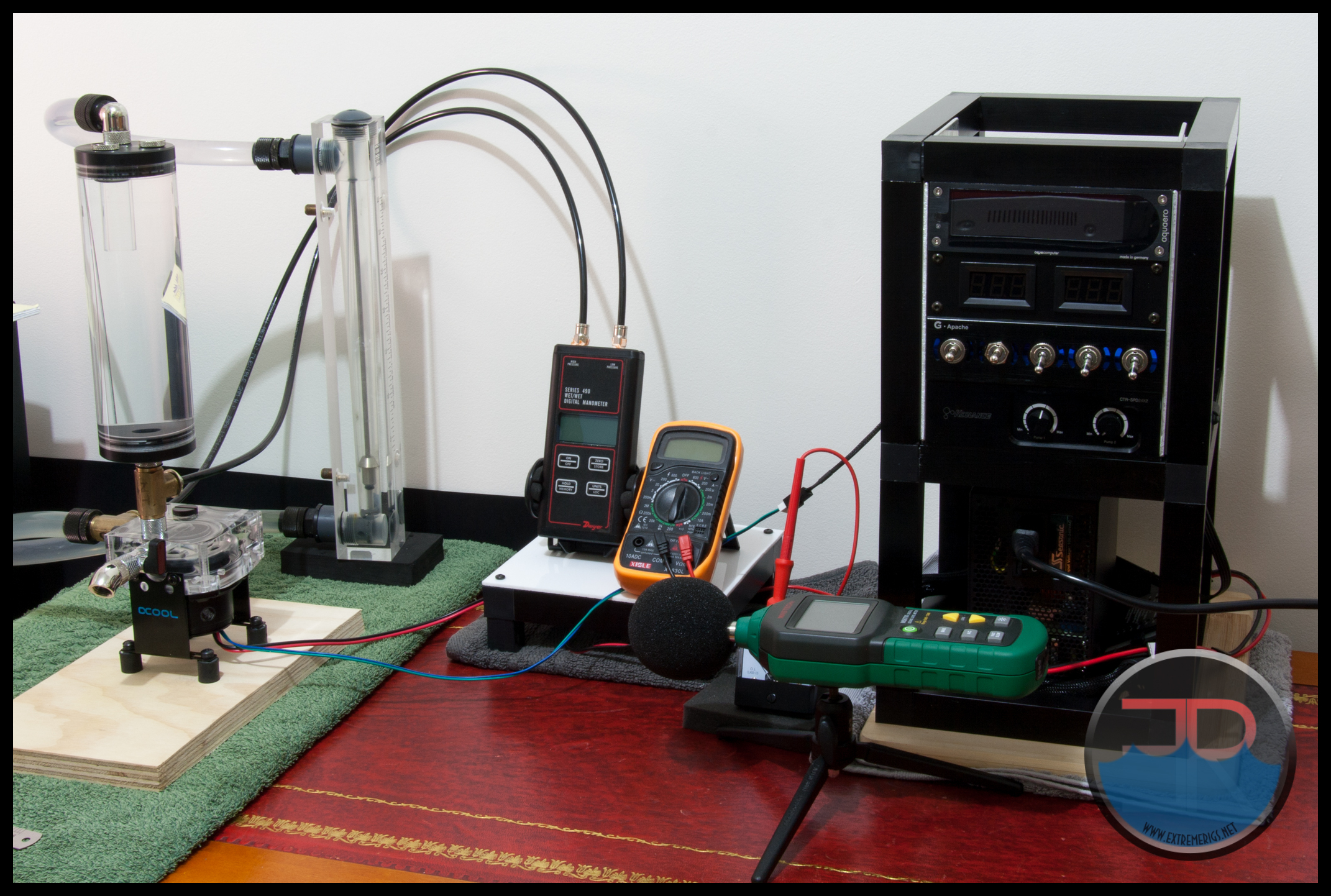 The sound meter detects a dog barking 2 blocks away so it is pretty sensitive. The noise floor achieved in the test area was a tad under 33 decibels which is pretty darn silent, and just breathing normally is detectable on the meter, so holding of breath was required for each data point recorded.
The sound meter detects a dog barking 2 blocks away so it is pretty sensitive. The noise floor achieved in the test area was a tad under 33 decibels which is pretty darn silent, and just breathing normally is detectable on the meter, so holding of breath was required for each data point recorded.
Now….in a possible oversight in the testing procedure, the data recorded was taken on a loop running virtually unrestricted. It was pointed out to me after testing was complete that the pump noise will change when under load and therefore my data may not be a true representation of the pump in “normal operation”. The next time I am testing a pump I will re-test the VPP755 at the same time and update that data into this review. For now, the data and comparisons are as already mentioned, taken from the almost unrestricted simple loop pictured above.
The VPP755 sound data on it’s own is probably meaningless unless you are familiar with how noise is measured, but we will display the results here for those who are interested. For everyone else, we also will compare the VPP755 against an Aqua Computer D5 PWM.
First off, here is the raw data for the VPP755 recorded when it was running on the Sound Bench. Perhaps a missing column is the “Stage” it is operating at, but I am pretty sure you can work out which is which.
 Normally we do our sound testing with the meter 12″ away from the noise source, however you may have noticed in the above table there are readings for both 1″ and 12″. The reason for this is that the D5 was noticeably louder compared to the VPP755 but the results were quite similar with the sound meter 12″ away. So both pumps were re-tested with the sound meter as close as possible (1″) which I think gave a better indication of the noise variance when plotted against each other.
Normally we do our sound testing with the meter 12″ away from the noise source, however you may have noticed in the above table there are readings for both 1″ and 12″. The reason for this is that the D5 was noticeably louder compared to the VPP755 but the results were quite similar with the sound meter 12″ away. So both pumps were re-tested with the sound meter as close as possible (1″) which I think gave a better indication of the noise variance when plotted against each other.
Lets look firstly at just the VPP755 sound testing results before we look at comparisons. We have chosen to display Noise vs. Flow Rate, but it could have been Noise vs. PSI. We decided not to plot against RPM due to the erratic RPM readings as was discussed on the control section of the review.
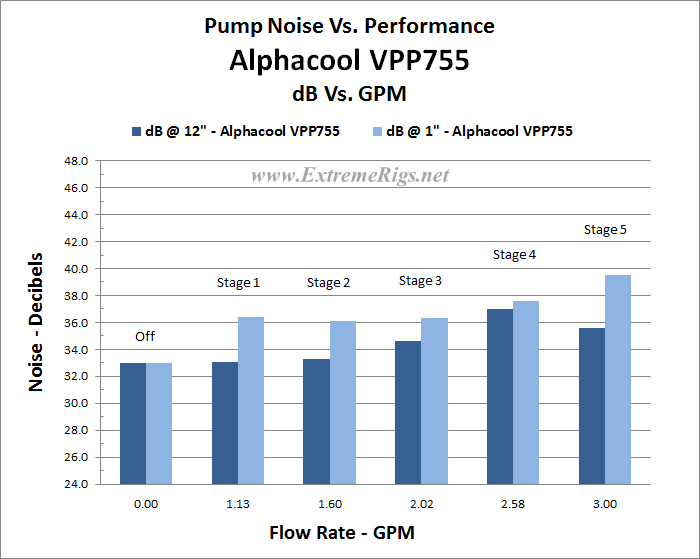 It is worth mentioning the Stage 4 reading at 12″. To the ear it did seem a bit louder, but the 1″ reading did not really show this up.
It is worth mentioning the Stage 4 reading at 12″. To the ear it did seem a bit louder, but the 1″ reading did not really show this up.
Next – how is the noise level of the VPP755 in comparison to a D5 pump? Let’s find out by plotting the data of the VPP755 against a D5 PWM and see what we get. Before that though, I will just mention that the D5 PWM pump was tested after the VPP755 and the PWM setting was tuned to match the Flow Rate (GPM) of each of the VPP755’s stages, which matched exactly the pressure also.
To help make sense of the plots below, we’ll post the D5 PWM raw data table here as well as again placing the VPP755 data table.

 First up is the 12″ readings. Here we see the VPP755’s loud stage 4 noise level being the outlier in noise performance. However at stage 5 the VPP is much quieter than the D5. Sometimes pumps and tops can have resonance issues with a setup which may or may not show up in the end user scenario. If you do see resonance we would suggest adjusting the pump speed to avoid it.
First up is the 12″ readings. Here we see the VPP755’s loud stage 4 noise level being the outlier in noise performance. However at stage 5 the VPP is much quieter than the D5. Sometimes pumps and tops can have resonance issues with a setup which may or may not show up in the end user scenario. If you do see resonance we would suggest adjusting the pump speed to avoid it.
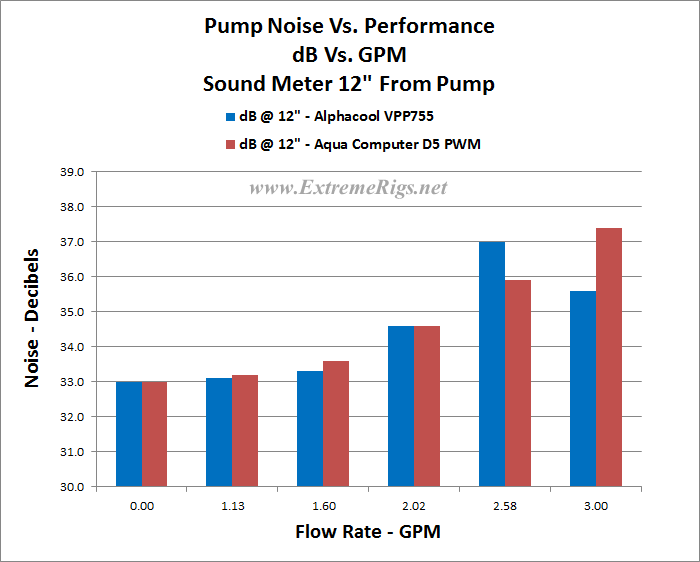 Let’s now look at the results when the noise meter was placed just 1″ away from the pump:
Let’s now look at the results when the noise meter was placed just 1″ away from the pump:
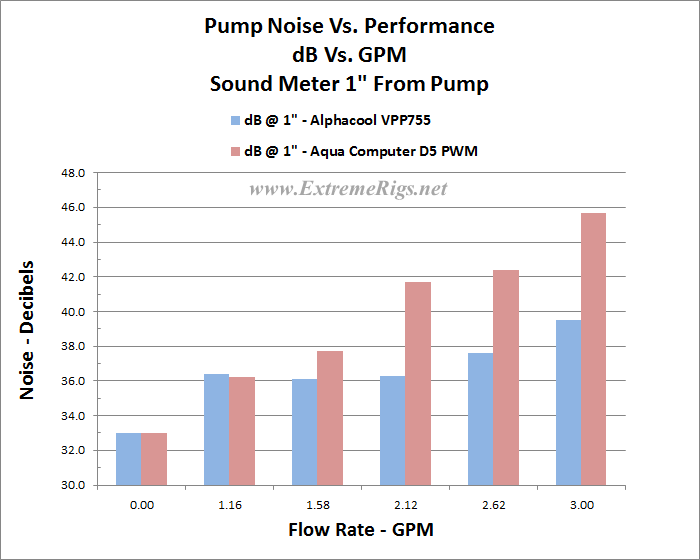 These results favor the VPP far more than the 12″ measurements. The VPP755 in fact seems far quieter than the D5 in 4 of the 5 flow rates tested at, and the other is virtually equal with each other and the ambient noise floor. It’s a pretty impressive set of results because the D5 is not a noisy pump anyway. However as the plots show the VPP755 appears much quieter for the same performance output.
These results favor the VPP far more than the 12″ measurements. The VPP755 in fact seems far quieter than the D5 in 4 of the 5 flow rates tested at, and the other is virtually equal with each other and the ambient noise floor. It’s a pretty impressive set of results because the D5 is not a noisy pump anyway. However as the plots show the VPP755 appears much quieter for the same performance output.
Using the data from the sound testing, we can also plot out some power usage charts.
Again lets look at the VPP755 on it’s own first in a Power for Performance chart.
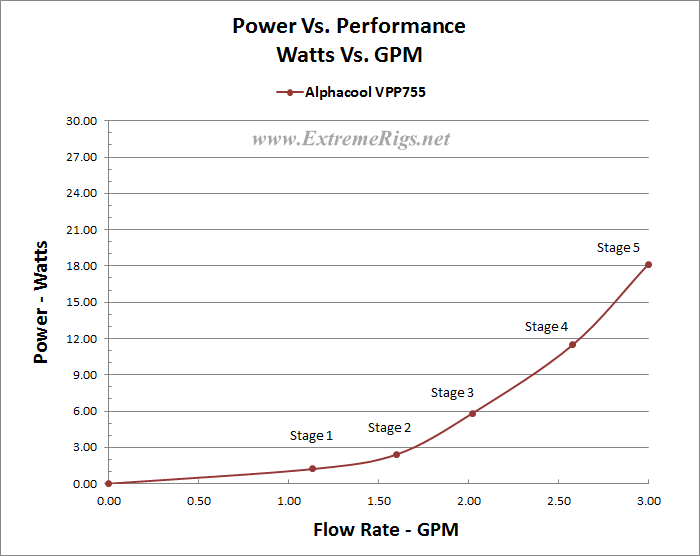 Now if we add the D5 PWM data onto the plot we clearly see that the VPP755 is using much less power than the D5 to achieve the same flow rate:
Now if we add the D5 PWM data onto the plot we clearly see that the VPP755 is using much less power than the D5 to achieve the same flow rate:
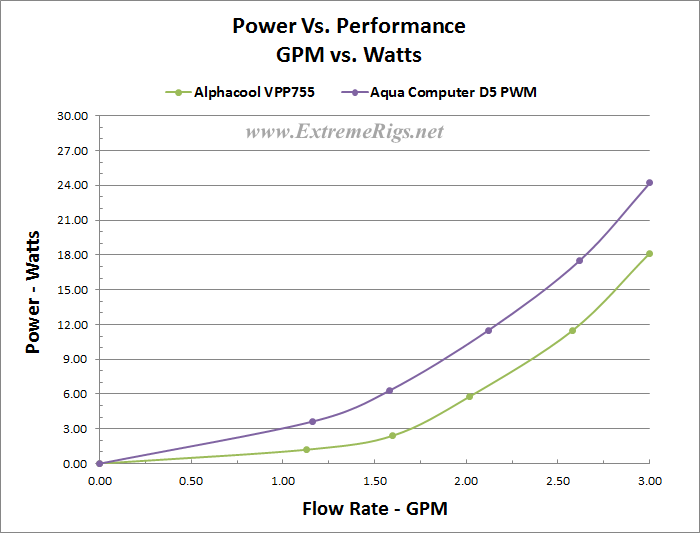 For the same output the VPP755 is clearly much more energy efficient. For the first 3 stages it uses less than half the power the D5 does to achieve the same output. The VPP wins on performance and energy efficiency which is quite astonishing. Another terrific result for the VPP755 to finish off with.
For the same output the VPP755 is clearly much more energy efficient. For the first 3 stages it uses less than half the power the D5 does to achieve the same output. The VPP wins on performance and energy efficiency which is quite astonishing. Another terrific result for the VPP755 to finish off with.
Next Up – Summary.







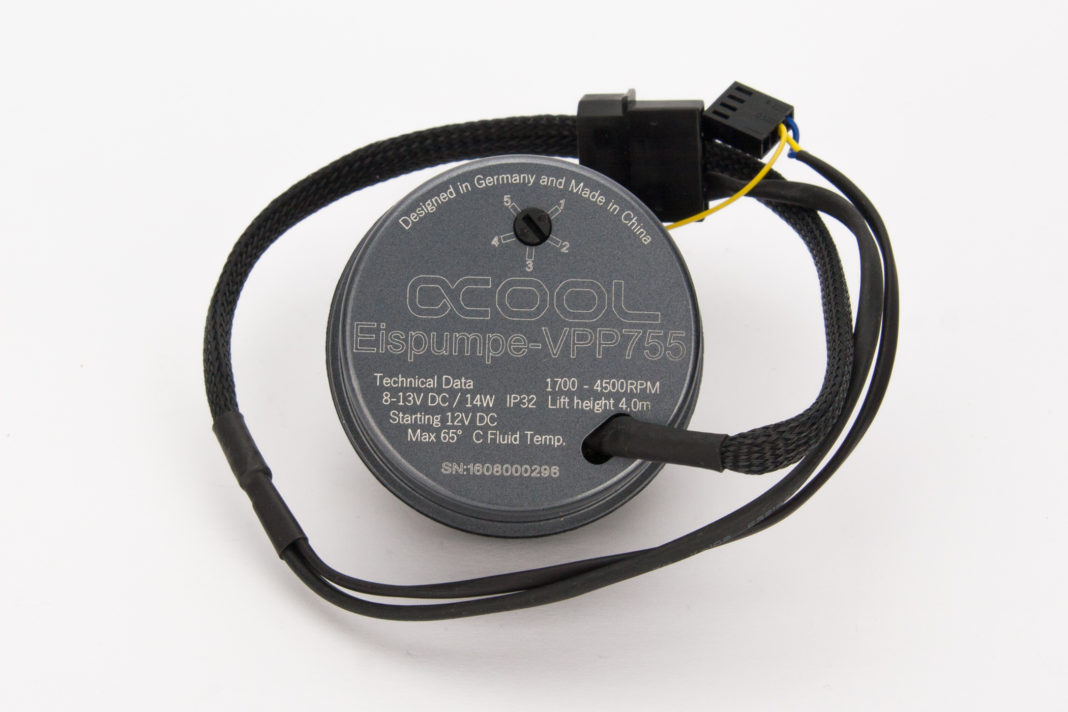




“What the VPP755 does not have yet is a proven track record for reliability”
Just offer a generous warranty, standing by the product.
Yeah and to be fair to Alphacool they claim that it has the same lifetime rating. So all things look good. However I’d always take a product known to last a long time than one that doesn’t even if the latter comes with a warranty. A pump dying can cause all sorts of hassles and I like my rigs to have high uptime and be foolproof cause I don’t have time to fiddle about much 🙂
The exact reason I switched to a D5, my ST mcp50x died after 9 months.
Alphacools false promises like being a true pwm pump & full compatability with existing tops is a major turn off. I’ll consider one when I can choose my own pump top and it actually has true pwm control. Until then ill stick with my Aqua Computer D5 pump motor with PWM input and speed signal.
[…] is all Ice (“Eis”) related. We recently reviewed the Eisbrecher radiator and the Eispumpe VPP755 along with it’s Eisdecke pump top. So we have already covered a fair amount of the new product line up. Neither the Eisbrecher […]
I just received my setup for my dual loops and after putting everything together for the pump/res and testing it for anyone needing to know the Alphacool VPP755 works in the Monsoon MMRS pump/res combo albeit about 2mm short with the o-ring provided by monsoon, but all i had to do was us a extra o-ring and slid it around the D5 cover by monsoon and it fit right in the gap and covers it so you don’t even notice it. I ran it for the first time yesterday and had no leaking issues, now that’s not to say it won’t later on but preliminary testing on my part went smoothly, also it is more quiet than any other pumps i’ve tried and it seems to be a strong pump will know more after testing it more, just FYI for anyone looking to use Monsoons system. Hope this helps.
Those considering buying this may want to wait until Alphacool fixes noise issues. Tons of reports: http://www.overclock.net/t/1624192/alphacool-vpp755-noise
Will this work in a 360mm rad for a CPU and 1 GPU block?
Yes for most common cpu and gpu blocks this will be plenty.
Comments are closed.